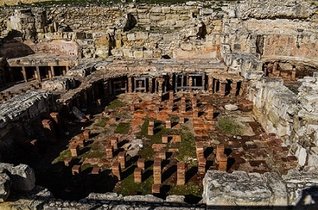One of the most common forms of excavation you will see is the initial grading and removal of soil just before a new subdivision is built. You will see scrapers that are removing hills and dirt and displacing it for haulage or land-fill; the bulldozers that are moving dirt to shape the streets and lots; the diggers that are removing the dirt in favour of house foundations, sewers and incoming plumbing; and the haulage trucks removing excavated materials not wanted or needed by the project. Together, these pieces of equipment make up the excavation platoon of vehicles. Another example of excavation is the practice of digging and taking away the covering in order to expose to view the remains of temples or old cities, and buried cultures.
Excavation work, at first, appears to be a robust and carefree process of aggressive digging and removal of dirt and aggregates. That may be so, but it can actually be fairly specific and detailed in its purpose, and careful steps leading to the objective of the excavation in the first place need to be taken. For example, anyone installing a swimming pool will require excavation, this is not a `bull in a china shop' type of job. Walls are shaped by the excavator and/or digger to the specs of the swimming pool's walls. The margin of error is not great so precautions are taken to be as exact as is required to keep the shape of the pool. Ironically, the removal of that pool will require the same demolition service as was required for the installation. The same could be said for the foundation of a home before it is built. Not just precise corners, but the foundation usually matches the shape of the structure to be built on it, and we often see curved rooms, even six sided rooms can be designed. The hole in the ground that receives the foundational concrete must be exact in the home's shape, and smoothly finished. It takes great skill and experience. The more exciting part of excavation is, of course, the ancient finds that continue to be discovered through ‘digging’ such as the recent find in 2015 of an ancient residential structure from 600 BC in an area that was really considered to be a large necropolis (cemetery) but appears to be a sub-division of the city of Rome, possibly proving that Rome was much larger than originally thought. It’s easy to state that excavation plays a big role in our cultural and historical knowledge pertaining to ourselves. While Demolition Company Toronto will probably not be involved in digging up dinosaurs and villages, we will be there for any projects you have that require tear down, abatement of soils, asbestos and mold, for drainage, swimming pool installation and removal or whatever your needs may be.
10 Comments
8/17/2020 11:41:18 pm
In Columbus, our company offers you reliable and expert craftsmanship for your building projects. With our expert excavators and premium equipment, we can guarantee that the job can be done in the safest and most efficient ways possible. We pay attention to every detail especially during the excavation phase to prevent future problems in drainage. We employ meticulous methods to avoid unnecessary and costly repairs that may result from hiring inexperienced excavation companies who perform the job haphazardly.
Reply
1/5/2023 10:58:08 pm
Hello blogger! Thanks for sharing the informative post on the benefits of using of excavation in the construction sector. Excavation is important in the construction industry, as it provides a safe and secure method of moving materials and ensuring that the construction site is kept safe and hazard-free. Excavation can also help prevent injuries and accidents by ensuring that construction workers are protected from any potential hazards. For additional information, you can also visit Boom & Bucket.
Reply
9/29/2023 05:49:45 am
Hello, Blogger! I want to express my appreciation for sharing such an informative post about the advantages of excavation in the construction sector. Excavation plays a pivotal role in the construction industry, offering a reliable and secure means of material transportation while maintaining safety and minimizing hazards on construction sites. It's also a vital tool for safeguarding construction workers from potential risks, reducing the likelihood of injuries and accidents.
Reply
10/5/2023 02:52:43 am
I wanted to express my gratitude for this post. I recently faced a similar situation, and your article provided me with the guidance I needed. Your willingness to share your experiences and knowledge is truly commendable.
Reply
10/11/2023 04:22:39 am
Looking forward to your future articles. Your expertise in this field is invaluable.
Reply
10/12/2023 08:42:58 am
This blog about excavation for foundations is a great read! It highlights the importance of construction and provides valuable insights. Thanks for sharing this informative content. It's definitely helpful for anyone looking to understand the foundation process better.
Reply
10/23/2023 07:52:23 am
Great post! Excavation is such a crucial step in the construction process, and providing stable holes for foundations is essential for a strong and durable structure. It's amazing how precision and expertise in excavation can make or break a building's integrity. Thanks for shedding light.👷🏗️
Reply
11/3/2023 03:27:31 am
This blog on foundation excavation is a must-read! It emphasizes the significance of construction and offers useful insights. Thank you for giving this useful information. It is unquestionably beneficial to anyone seeking a deeper understanding of the foundation process.
Reply
11/3/2023 09:21:29 am
I can see the effort and time you put into crafting this post. It's evident that you're passionate about what you write. Thank you for sharing your knowledge.
Reply
5/8/2024 03:05:45 am
Great post! Excavation is such a crucial step in the construction process, and providing stable holes for foundations is essential for a strong and durable structure.
Reply
Leave a Reply. |
Author Archives
January 2024
Categories |
ABOUT DEMOLITION company torontoThe professionals at Demolition Company Toronto are really talented guys with a ton of knowledge and experience; you're in great hands and you can count on the best insights available for your demolition requirements....MORE
|
OUR SITE |
OUR SERVICE AREA
|
Website by RoughRider


 RSS Feed
RSS Feed